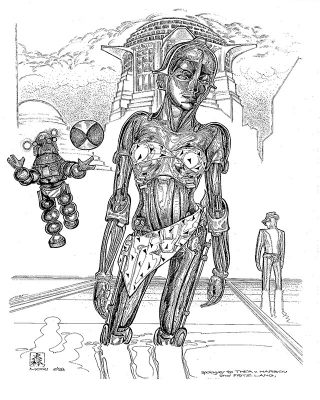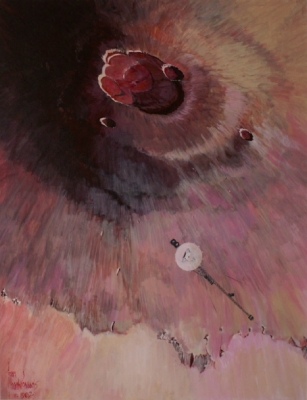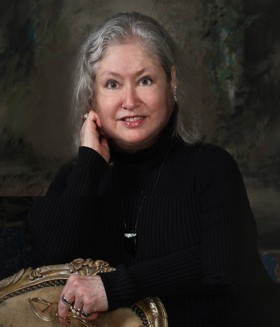The Golden Age of Science Fiction: Joan Hanke-Woods
 td> |
The Fan Activity Achievement Awards, or FAAN Awards were founded in 1976 by Moshe Feder and Arnie Katz. Created to highlight writing in fandom, they differed from the Fan Hugos in that they were voted on specifically by fanzine fans. The original awards were presented at various convention. Following the 1980 awards, the awards were on hiatus until 1994 and have been presented each year since, with the exception of 1996. Joan Hanke-Woods won the last of the original run of FAAN Awards for Best Fan Artist—Serious, her second consecutive win. The first winner was Jim Shull. The category was not revived after the hiatus, being combined with the Best Fan Artist—Humorous category and replaced by the Best Fan Artist category.
Over the years, joan hanke-woods used a variety of monikers for her artwork. By the time I got to know her, she was using the name delphyne woods. She first discovered fandom in 1978 at Windycon V and rapidly began providing artwork for fanzines. She won the FAAN Awards in 1979 and 1980. While the FAAN Awards are given by fanzine fandom and the Hugos are presented by a more varied electorate, her work gained recognition and from 1980 through 1986, she was nominated for the Hugo Award for Best Fan Artist, eventually winning in 1986.
Through the late 1970s and the 1980s, she also began to publish artwork for professional magazines and publishers, with her work appearing in Galaxy, on books by Joan D. Vinge and Philip José Farmer and other authors. She eventually gafiated, but began to create fannish art again in around 2008 and also began the process of scanning her old artwork for electronic storage and dissemination.
In addition to having her work recognized with the Hugo and the FAAN Awards, woods was honored as a guest at ConClave V in 1980, Archon 5 in 1981, Windycon XI in 1984, Xanadu III in 1986, and both Capricon 7 and Bubonicon 19 in 1987.
She died suddenly on September 16, 2013 of unknown causes. Each year, her friends continue to toast to her memory at Windycon which was not only her first convention, but also tends to fall one or near her birthday.
On a personal note, I twice commissioned artwork from woods, first for the cover of issue eight of my fanzine, Argentus, and later for the second bidzine published by the Chicago in 2012 Worldcon committee, for short story by Mike Resnick, for which she paid homage to Weird Tales artist Margaret Brundage. The original artwork for her Argentus cover hangs on my wall.
I asked Richard Chwedyk, a mutual friend of mine and delphyne’s if he would like to add a couple of paragraphs to what I’ve written. Richard provided me with the following:
I first met Delphyne Woods around 1979 or 1980, while we were both working in the composing room at Pioneer Press Newspapers in Wilmette. She wore a green army jacket with a “Nostromo” patch on one of the sleeves. I asked her about it. She answered me like I was a “mundane.” At the time, I probably was. I’d just gotten my B.A. from Columbia, and my good teachers there had beaten all the SF out of me—so they thought. Delphyne was still Joan Hanke-Woods at that time, and after a while I convinced my creds were there.
I ‘d read fanzines, but I was too chicken to attend cons, not until I met her. The first con I ever attended, she was Fan Artist GoH at Windycon. In that way, she was indirectly responsible for my “career” (such as it is) in science fiction.
At Pioneer, I got to see a lot of her artwork, like the illustrations she did for Galaxy in their last days. I don’t remember if she ever got paid for them. Every minute she wasn’t working, or reading, or eating lunch, she was drawing. She never stopped working. I can’t remember seeing her without pens and paper immediately at hand.
I remember a painting she did for Mike Stein’s Fantastic Films magazine, of that weird giant worm thing that lived in an asteroid—that scene from The Empire Strikes Back, I think. It was incredible, especially if you examined it up close, in detail: all sorts of textures and tiny flashes of colors set against other flashes of color. The painting was on display at a con in Denver when it was ripped off. Stolen. Never recovered—not the artwork, not Delphyne. It wasn’t the first time she was ripped off, nor the last.
She loved SF. She loved fandom. But there were a lot of folks in fandom who could make her regret her passion. This isn’t to say there weren’t good people around, trying to help her whenever they could. Kelly-Freas once told her, “It’s a CRIME you’re not working as a pro!” But for most of her professional years she worked as a legal secretary or administrative assistant in various law offices.
Before she went into the legal business, she had one last job in graphics, at a little studio in Evanston. Delphyne had been nominated for Hugos numerous times, but the year she finally won, her boss at the graphics studio expressly forbade her from taking a vacation the weekend of the Atlanta Worldcon. She couldn’t walk out. She had to make a living. So the day that should have been her moment of triumph, she wasn’t there.
In her later years, she attended cons but hardly ever ventured out of her room. She was showing signs of agoraphobia, and whenever I was around I tried to get her to go out as much as possible, because when she did she was fine. We’d go out to dinner with fans and pros and academics and other artists and she would have the time of her life. But when the evening ended she’d hide back in her room. She slept with the TV on. I didn’t realize it at the time, but she was also suffering from a kind of PTSD, or worse.
It was about 2007 or 2008, late one evening when we were in the hotel bar at a Windycon that she finally spilled out to me that years before, at some tiny con somewhere downstate, she had been sexually assaulted: drugged and forced to have sex with a number of people. I finally understood her aversion to being out in the con. She could be having a great time and then one little thing—something she saw, or someone she saw—might bring it all back. I suggested she seek help, but it was hard enough to get her to go to a doctor for physical problems (injuries from the days when she earning her black belt in karate). It didn’t help that most of those law offices had the lousiest of health plans, but even if she had something like gold standard healthcare, it would have taken a herculean labor to get her to a therapist.
Delphyne was an infinity of mysteries. I knew her for thirty-three years and she could still come up with memories and instances in her life I had never heard before. When she set up for an art show, she hated my hanging around; she was so careful about where she placed each work in relation to the other works, and how they would look to the casual observer traipsing through the art show room. After she ordered me out of the art show room, she explained, later, at dinner, that for several years she had worked on the window displays at Wieboldt’s, the downtown department store now long gone. Her tough boss trained her and explained to her that it wasn’t just what you placed in the window, but how you placed it there—and that was a kind of art form in and of itself.
She had dozens of jobs that were not, in any way, ostensibly related to art. But she never stopped being an artist. And let’s face it: in this world there are few things that demand more raw courage than to be an artist—not just to do art, but to be art, fully, in one’s heart and soul. She was brilliant and brave and generous to a fault. She could also be demanding, irascible, self-absorbed and she could drive you crazy at times, but we all drive each other crazy at times.
She could be a good friend and a bad friend, but she was always a friend, and I’ll never forget that, forget her, the rest of my life.
Thanks to Jo Van Ekeren, we know that Hanke-Woods had to best Victoria Poyser for the FAAN award in this category.
 Steven H Silver is a sixteen-time Hugo Award nominee and was the publisher of the Hugo-nominated fanzine Argentus as well as the editor and publisher of ISFiC Press for 8 years. He has also edited books for DAW, NESFA Press, and ZNB. He began publishing short fiction in 2008 and his most recently published story is “Webinar: Web Sites” in The Tangled Web. His most recent anthology, Alternate Peace was published in June. Steven has chaired the first Midwest Construction, Windycon three times, and the SFWA Nebula Conference 6 times, as well as serving as the Event Coordinator for SFWA. He was programming chair for Chicon 2000 and Vice Chair of Chicon 7.
Steven H Silver is a sixteen-time Hugo Award nominee and was the publisher of the Hugo-nominated fanzine Argentus as well as the editor and publisher of ISFiC Press for 8 years. He has also edited books for DAW, NESFA Press, and ZNB. He began publishing short fiction in 2008 and his most recently published story is “Webinar: Web Sites” in The Tangled Web. His most recent anthology, Alternate Peace was published in June. Steven has chaired the first Midwest Construction, Windycon three times, and the SFWA Nebula Conference 6 times, as well as serving as the Event Coordinator for SFWA. He was programming chair for Chicon 2000 and Vice Chair of Chicon 7.
 Richard Chwedyk is a Nebula Award-winning science fiction writer who teaches science fiction writing at Columbia College Chicago. He has also taught classes in short story writing for Oakton Community College since 1991.
Richard Chwedyk is a Nebula Award-winning science fiction writer who teaches science fiction writing at Columbia College Chicago. He has also taught classes in short story writing for Oakton Community College since 1991.
His stories and poems have appeared in such places as The Magazine of Fantasy and Science Fiction, Amazing Stories, Space and Time, Tales of the Unanticipated, Snow Monkey, Oyez Review, The Drink Tank, Hypertextmag.com and in such anthologies as Hell in the Heartland, Tales From the Red Lion, Visual Journeys, Cthulhu and the Coeds, or: Kids and Squids, 80! Memories & Reflections on Ursula K. Le Guin, The 2005 Rhysling Anthology, Nebula Awards Showcase 2004 and Year’s Best SF 7 and 8.


[…] THE COVER. Steven H Silver’s latest feature for Black Gate pays tribute to a superb sff artist: “The Golden Age of Science Fiction: Joan Hanke-Woods”. And Richard Chwedyk contributes a section about her life nearly all of which was new to […]
Thanks for this. I wasn’t previously aware of her.
I recently purchased a stack of art at an estate sale. Included is a painting signed Joan Hanke-Woods. Any suggestions on who might want this?
I remember Joan from Kubla Khans in Nashville 1979-84. The first time I met her it was in an elevator, she was in a macrame swimsuit and you could see right through it, no joke. There was a laissez faire attitude about sex at conventions back then and it was till the Seventies and AIDS was not a thing yet. Her amazing personality was legendary I am sure.